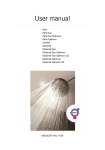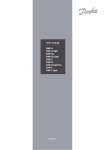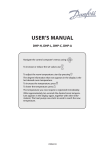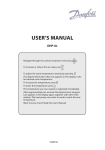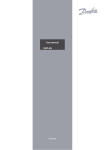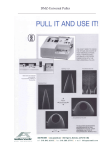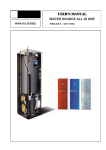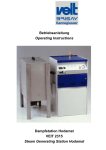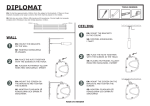Download User manual - Source Energy
Transcript
User manual Atria Atria Duo Atria Duo Optimum Atria Optimum Comfort Diplomat Diplomat Duo Diplomat Duo Optimum Diplomat Duo Optimum G2 Diplomat Optimum Diplomat Optimum G2 086U6297 Rev. 6 EN If these instructions are not followed during installation and service, Thermia Värme ABliability according to the applicable war‐ ranty is not binding. Thermia Värme AB retains the right to make changes to com‐ ponents and specifications without prior notice. © 2010 Copyright Thermia Värme AB. The Swedish language is used for the orig‐ inal instructions. Other languages are a translation of original instructions. (Directive 2006/42/EG) Contents 1 2 3 Important information.................................................................................. 3 1.1 Safety precautions........................................................................................ 4 1.2 Protection.................................................................................................... 5 About your heat pump................................................................................. 6 2.1 Principles of function.................................................................................... 6 2.2 Components................................................................................................. 7 2.3 Outdoor and defroster function..................................................................... 10 2.4 Passive cooling function.............................................................................. 12 2.5 Speed (rpm) control.................................................................................... 12 2.6 HGW technology........................................................................................ 12 2.7 Auxiliary heat............................................................................................. 13 2.8 Water heater.............................................................................................. 14 Control computer...................................................................................... 17 3.1 Control system........................................................................................... 17 3.2 Display...................................................................................................... 19 4 Trimming the heating system...................................................................... 23 5 Instructions.............................................................................................. 25 6 7 5.1 Setting operating mode................................................................................ 25 5.2 Setting ROOM values.................................................................................. 25 5.3 Adjusting CURVE values.............................................................................. 26 5.4 Adjusting a specific part of the heat curve...................................................... 26 5.5 Setting MIN and MAX values........................................................................ 26 5.6 Setting HEATSTOP..................................................................................... 27 5.7 Reading off temperatures............................................................................. 27 5.8 Calculating energy consumption................................................................... 28 5.9 Manual defrost, outdoor unit........................................................................ 33 Regular checks......................................................................................... 34 6.1 Checking operation..................................................................................... 34 6.2 Checking the brine level.............................................................................. 34 6.3 Checking the water level in the heating system.............................................. 35 6.4 Checking the safety valve............................................................................ 36 6.5 In the event of leakage................................................................................ 36 6.6 Cleaning the strainer for the heating system................................................... 37 6.7 Cleaning the strainer for the brine circuit....................................................... 38 Accessories............................................................................................... 39 086U6297 Rev. 6 EN – 1 7.1 Room sensor.............................................................................................. 39 8 Troubleshooting........................................................................................ 41 9 Terms and abbreviations............................................................................ 43 8.1 10 11 Alarm........................................................................................................ 41 Default setting in the control computer....................................................... 45 References............................................................................................. 46 11.1 Check list................................................................................................ 46 11.2 Installation carried out by:......................................................................... 47 2 – 086U6297 Rev. 6 EN 1 Important information Note! If the installation is not used during the winter, the heating system must be drained of water, otherwise there is a risk of frost damage to the installation. The system can be considered maintenance free but certain checks are necessary. Before changing the control computer’s settings, first find out what these changes mean. Contact your installer for any service work. Caution! This apparatus is not intended for persons (including children) with reduced physical, sensory or psychological capacity, or who do not have knowledge or experience, unless supervised or they have received instructions on how the apparatus functions from a safety qualified person. Note! Children are not permitted to play with the apparatus. User manual 086U6297 Rev. 6 EN – 3 1.1 Safety precautions 1.1.1 Installation och underhåll DANGER! Only authorized installers may install, operate and carry out maintenance and repair work on the heat pump. DANGER! Only authorized electricians may modify the electrical installation. DANGER! DANGER TO LIFE! Only authorized refrigeration technicians may work on the refrigerant circuit. 1.1.2 Förändringar av systemet Only authorized installers may carry out modifications on the following components: • • • The heat pump unit The pipes for the refrigerant, brine, water and power The safety valve Do not carry out construction installations that may affect the operational safety of the heat pump. 1.1.3 Säkerhetsventil The following safety precautions apply to the hot water circuit’s safety valve with corresponding overflow pipe: • • Never block the connection to the safety valve’s overflow pipe. Water expands when it is heated, this means that a small amount of water is released from the system via the overflow pipe. The water that exits the overflow pipe can be hot! Therefore, allow it to flow to a floor drain where there is no risk of burning yourself. 4 – User manual 086U6297 Rev. 6 EN 1.2 Protection 1.2.1 Korrosionsskydd Due to the risk of corrosion, avoid using different types of sprays in the vicinity of the heat pump. This particularly applies to: • • • • Solvents Chlorinated cleaning agents Paints Adhesives User manual 086U6297 Rev. 6 EN – 5 2 About your heat pump 2.1 Principles of function A heat pump utilises the free energy from the sun and that is also found in a natural heat source, such as rock, ground, ground water or air. The heat pump can be compared to a reversed refrigerator; in a refrigerator heat is transferred from the inside of the refrigerator to the outside, whereas in a heat pump, the solar energy that is stored in a heat source is transferred to the inside of the house. The heat pump uses the solar energy in the heat source and gives back two to three times more heat energy than it uses in electrical energy. The heat pump is, therefore, a very environmentally friendly and economical way of heating a house. Figure 1. The relationship between consumed electrical energy and free solar energy In order for the heat pump to be able to retrieve heating energy from the heat source and transfer it to the heating system of the house, three 6 – User manual 086U6297 Rev. 6 EN separate fluid circuits are required. The figure below shows the different circuits and how they work together in the transfer of heat energy. C 3 4 2.2 B 2 A 1 A fluid (brine) (A) filled hose is lowered into a lake, buried in the ground or low‐ ered into bedrock. The cold brine obtains energy from the heat source by the fluid temperature in the hose being heated a few degrees by the surround‐ ing heat source. The fluid filled hose is also known as a collector. The heated brine (A) is routed into the heat pump's evaporator (1) and heats the enclosed refrigerant (B). The heat in the enclosed refrigerant in the refrigerant circuit (B) is increased due to a pres‐ sure increase in the compressor (2). The extremely hot refrigerant, which is now in a gaseous state, continues into the condenser. The heating system transports the heat energy out to the water heater, radiators or the under floor heating system, which indirectly heat up the house (3). Here, the refrig‐ erant is cooled and releases its heat energy to the heating system. The refrigerant’s temperature decreases and condenses back to a liquid state. The refrigerant is then transported through the expansion valve (4) where the pressure drops and the refrigerant starts to boil and then the process starts again. Components The heat pump is a complete heat pump installation for heating and hot water. It has an integrated hot water tank and auxiliary heater. Using the TWS (Tap Water Stratificator) technique, more effective heat transfer and efficient layering of the water in the water heater is achieved. The heat pump is equipped with control equipment, which is operated via a control panel. User manual 086U6297 Rev. 6 EN – 7 Heat enters the house via a water borne heating system. The heat pump supplies as much of the heat demand as possible before auxiliary heating is engaged and assists. 8 – User manual 086U6297 Rev. 6 EN The heat pump unit consists of five basic units: Symbol explanation 3 1 Heat pump unit • • • 5 • 2 2 • 1 3 Stainless steel heat exchanger Circulation pumps for brine and heating systems Valves and safety equipment for cooling systems and corresponding electrical components. Water heater • 4 Compressor Internal anti-corrosion protection with copper or made completely of stainless steel It has an anode that normally does not require replacing, which means that it is maintenance-free Exchange valve or shunt valve • The heated water either passes through to the heating system or to the water heater depending on whether heating or hot water is to be produced User manual 086U6297 Rev. 6 EN – 9 Symbol explanation 4 Auxiliary heat • • • 5 Immersion heater installed on the heating system’s supply line Covers the demand of extra energy if the heat pump’s capacity is excee‐ ded Automatically connected if operating mode AUTO is selected. Control equipment • • • Control panel Temperature sensors (outdoor, sup‐ ply line, return line, brine and hot water) Room sensor (option) The control equipment controls the heat pup unit’s included components (compressor, circulation pumps, auxiliary heaters and exchange valve) and determines when to start and stop the pump as well as producing heat for the house or hot water. 2.3 Outdoor and defroster function Atria models are equipped with an outdoor unit that uses air as a heat source down to -20°C. The outdoor unit has a coil where brine recovers free energy from the outside air. It also has a fan that increases the airflow through the coil. During operation the coil is cooled by the energy exchange at the same time as the humidity causes it to become covered in frost.Atria models have an automatic function to defrost the coil using the produced heat energy. If necessary, a defrosting sequence starts which means the following: • • The defrosting sequence starts when the temperature of the brine reaches its set parameter for defrosting. The compressor is stopped so that the defrosting sequence should not load the compressor unnecessarily. On the other hand the com‐ pressor is not stopped when it produces hot water because the water heater is cooled when defrosting. The fan on the outdoor unit is 10 – User manual 086U6297 Rev. 6 EN • • • • • stopped in conjunction with defrosting to shorten the time of defrost‐ ing. The shunt valve in the heat pump opens so that hot brine from the defrosting tank is mixed with the cold brine circulating to the outdoor unit. The mixture has a temperature of about 15°C. The fifteen degree heated brine melts the frost on the outside of the coil at the same time as the liquid is cooled. When the brine is no longer cooled to temperatures below 11°C the coil is sufficiently defrosted. The shunt valve closes the flow of hot brine from the defrosting tank. Operation returns to normal. The unit (Atria models) consists of the following basic components: 2 3 1 • • • 1 Figure 2. The figure shows Atria Duo, equipped with a sepa‐ rate water heater Heat pump unit • 2 Stainless steel heat exchanger Circulation pumps for brine and heat‐ ing systems Valves and safety equipment for cool‐ ing systems and corresponding elec‐ trical components. Water heater • • • 3 Compressor Internal anti-corrosion protection with copper or made completely of stainless steel It has an anode that normally does not require replacing, which means that it is maintenance-free Defrosting tank containing heated brine for defrosting the outdoor unit Outdoor unit • • Heat exchanger Fan User manual 086U6297 Rev. 6 EN – 11 2.4 Passive cooling function Note! Not sold on all markets. Heat pump Comfort is equipped with an extra heat exchanger to use the passive cooling effect from the brine. Because the temperature in the collector (borehole or equivalent) is lower than the indoor temperature, the temperature difference can be exploited to cool the radiator circuit. At the same time the collector is charged with energy before the cold periods of the year. Comfort is a complete installation for heating, hot water and passive cooling where the control automatically ensures that the desired indoor climate is reached. Because Comfort uses the same pipe system for heating and cooling, it is important to use a temperature that does not cause condensation on the pipe system when cooling. (If the system is not adapted to it.) Use of fan convectors is recommended. 2.5 Speed (rpm) control Applies from Optimum A heat pump requires optimum conditions in the heating system and brine circuit in order to be able to run as efficiently as possible. The temperature difference between the heating system’s supply line and return line must be constant between 7–10°C. For the brine circuit a temperature difference of 3°C between supply and return line applies. If the differences are greater or less, the heat pump is less efficient and savings are lower. A heat pump with speed controlled circulation pumps always ensures that they retain the temperature differences. The control equipment detects if the balance is in jeopardy and increases or decreases the speed of the circulation pumps as necessary. 2.6 HGW technology The HGW technique is a new and unique method for hot water heating, which is used in Diplomat Optimum G2 and Diplomat Duo Optimum G2. At the same time as the water is heated to be distributed around the house heating system, a small proportion flows via an extra de-super‐ 12 – User manual 086U6297 Rev. 6 EN heater, which heats the water before it enters the water heater. A shunt valve controls the flow between hot water and heating system. During heating production, the shunt ensures a certain flow over the desuperheater to the water heater. The flow through the shunt is continu‐ ously regulated by the heat pump control by sending opening or closing pulses to the shunt. 2.7 Auxiliary heat Diplomat models, Comfort If the heat demand is greater than the heat pump’s capacity, the auxiliary heater engages automatically in operating mode AUTO. The auxiliary heater is made up of an electric heating element on the supply pipe that has two outputs, ADD.HEAT 1 and ADD.HEAT 2, and can be controlled in three steps. For three phase, 400V 3N, installations: • • • Step 1 = ADD.HEAT 1 = 3 kW Step 2 = ADD.HEAT 2 = 6 kW Step 3 = AUX. HEAT 1 + AUX. HEAT 2 = 9 kW For single phase, 230V 1N, installations (not Comfort) • • • Step 1 = ADD.HEAT 1 = 1.5 kW Step 2 = ADD.HEAT 2 = 3 kW Step 3 = AUX. HEAT 1 + AUX. HEAT 2 = 4.5 kW In the event of an alarm, the auxiliary heater engages automatically on the condition that operating mode AUTO is selected and that at least one additional step is permitted. Atria models The auxiliary heater for 400V 3N heat pumps is made up of an electric heating element on the supply line that has three outputs, AUX. HEAT 1, AUX. HEAT 2 and AUX. HEAT 3, and can be controlled in five steps: • • • • Step 1 = ADD.HEAT 1 = 3 kW Step 2 = ADD.HEAT 2 = 6 kW Step 3 = AUX. HEAT 1 + AUX. HEAT 2 = 9 kW Step 4 = ADD.HEAT 2 + ADD.HEAT 3 = 12 kW (only connected at switched off compressor) User manual 086U6297 Rev. 6 EN – 13 • • • Step 5 = ADD.HEAT 1 + ADD.HEAT 2 + TILLSATS 3 = 15 kW (only connected at switched off compressor) Step +4 = ADD.HEAT 2 + ADD.HEAT 3 = 12 kW (compressor operation permitted) Step +5 = ADD.HEAT 1 + ADD.HEAT 2 + ADD.HEAT 3 = 15 kW (compressor operation permitted) The two power steps, step 4 and step 5, cannot be activated when the compressor is running. There are further auxiliary heating steps: step +4 and step +5, which means that these additional steps can be activated whilst the compressor is running. Step +4 and +5 must only be selected on the condition that the building where the heat pump is installed has a large heating demand and the building’s electric installation is suitable for high current consumption. The auxiliary heater for 230V 1N heat pumps is made up of an electric heating element on the supply line that has two outputs, AUX. HEAT 1 and AUX. HEAT 2, and can be controlled in three steps: • • • Step 1 = ADD.HEAT 1 = 1.5 kW Step 2 = ADD.HEAT 2 = 3 kW Step 3 = AUX. HEAT 1 + AUX. HEAT 2 = 4.5 kW In the event of an alarm, the auxiliary heater engages automatically on the condition that operating mode AUTO is selected and that at least one additional step is permitted. 2.8 Water heater Thermia heat pumps Diplomat, Diplomat Optimum, Diplomat Optimum G2 and Comfort supplied with an integrated 180 litre water heater. They 14 – User manual 086U6297 Rev. 6 EN are equipped with a TWS coil that means more effective heat transfer and efficient layering of the water in the water heater. 2 7 1 8 Symbol explanation 6 3 1 Tap hot water 2 Peak temperature sensor 3 Water heater 4 TWS coil 4 5 Start temperature sensor 5 6 Supply line to TWS coil 7 Return line from TWS coil 8 Cold water line Water heater for Diplomat mod‐ els, Comfort Hot water production is prioritised ahead of heat production, i.e. no heat is produced when there is a hot water demand at the same time. The temperature of the hot water cannot be adjusted. Normally, hot water production does not cease at a determined temperature but when the compressor’s operating pressure switch reaches its maximum oper‐ ating pressure, which corresponds to a hot water temperature of approx‐ imately 50-55°C. Using a regular time interval, the water in the water heater is given extra heat by the integrated auxiliary heater to prevent the build up of bacteria (anti-legionella function). The factory set time interval is seven days (can be adjusted). When the anti-legionella function is active the heat pump produces hot water until the temperature for the start temperature sensor (5) has reached 60°C. If the heat pump cannot raise the temperature sufficiently within 3.5 hours the control checks if there is any heating requirement, before the anti-legionella function tries again. In the control system’s TEMPERATURE menu, a number of measured and calculated temperatures for the hot water and supply are displayed. The current temperature for the peak temperature sensor (2) and the temperature of the supply line during heating and hot water production are displayed. The temperature of the supply line often exceeds the User manual 086U6297 Rev. 6 EN – 15 maximum permitted hot water temperature, but usually during hot water production. The hot water heaters for Atria models differ from the other heat pumps in that the function for defrosting the outdoor unit is different. The only difference between an Atria/Atria Optimum and an Atria Duo/ Atria Duo Optimum is that the water heater is integrated in Atria/Atria Optimum and a separate unit for Atria Duo/Atria Duo Optimum. The integrated 180 litre hot water heater has a defrosting tank (mantle) on the outside of the heater that contains heated brine (approx 47 litres) which is used during defrosting. 1 6 7 2 8 Symbol explanation 1 Tap hot water 2 Peak temperature sensor 3 Defrosting tank 3 4 Water heater 4 5 TWS coil 6 Cold water line 7 Supply line to TWS coil 8 Expansion outlet when outdoor unit is positioned at high level 5 Figure 3. Water heater with defrosting tank 16 – User manual 086U6297 Rev. 6 EN 3 Control computer 3.1 Control system The heat pump has an integrated control system which automatically calculates the heat demand in the house to ensure that the correct amount of heat is produced and emitted where necessary. There are many different values (parameters), which are required in order to do the calculation of the heat demand. During installation and service, the control panel is used to set and change values that have to be adapted according to the house demand. The control panel consists of a display, a keypad and an indicator. In the display, a simple menu system is used to navigate the desired set‐ User manual 086U6297 Rev. 6 EN – 17 tings and values. During operation, the display always shows the set ROOM value, the operating mode and the status of the heat pump. ROOM 20°C NO HEAT DEMAND 1 OPERAT. AUTO 2 3 Figure 4. Position Display, keypad and indicator. (20°C) Description 1 The display text and symbols are only shown as examples. Cer‐ tain symbols cannot be displayed at the same time. 2 Keypad: + Plus sign used to scroll up a menu or increase the values. - Minus sign used to scroll down a menu or reduce the values. > Right arrow used to select a value or open a menu. < Left arrow to cancel selection or exit a menu. 3 Indicator The control system is operated via a user-friendly menu system, which is shown in the display. Use the keypad’s four navigation symbols to navigate the menus and increase or reduce the set values. The INFORMATION menu is used to adjust the following: • • • Operation Heat curves Temperatures 18 – User manual 086U6297 Rev. 6 EN • • Operating time Menu system language The INFORMATION menu is opened by pressing the left or right buttons. The indicator at the bottom of the control panel has three modes: • • • 3.2 Not lit, means that the heat pump is not powered. When the light shines continuously, the heat pump has power and is ready to produce heat or hot water. Flashing, means an active alarm Display The display shows information about the heat pump’s operation, status and any alarms, in text form. Operating mode and status, indicated by symbols, are also shown in the lower part which shows the heat pump’s active processes. Note! To change the display language, press the following sequence of buttons: right arrow, arrow down to bottom menu, arrow right, scroll between languages using + or -. Then select language using right arrow. User manual 086U6297 Rev. 6 EN – 19 3.2.1 Operating modes Table 1. Shows the set operating mode of the heat pump. Operating mode Meaning (OFF) The installation is fully switched off. This mode is also used to acknowledge certain alarms. Caution! If the operating mode OFF is to be used for long periods during the winter, the water in the heating system in the heating system must be drained, otherwise there is a risk of frost damage. AUTO The heat pump and the auxiliary heater are automatically controlled by the control system. HEAT PUMP The control system is controlled so that only the heat pump unit (compressor) is allowed to operate. In this operating mode peak heating charging (anti-legionella function) of the hot water will not run because the auxiliary heater is not used. AUX. HEATER The control system only permits the auxiliary heater to be in operation. HOT WATER In this mode the heat pump only produces hot water, no heat goes to the heating system. Caution! If the operating mode HOT WATER is to be used for long periods during the winter, the water in the heating system in the heating system must be drained, otherwise there is a risk of frost damage. 20 – User manual 086U6297 Rev. 6 EN 3.2.2 Symbols Table 2. Symbols shown in the display. Symbol HP Meaning Indicates that the compressor is in operation. LIGHTNING Indicates that the auxiliary heater is in operation. The number indicates what additional step is activated. F HOUSE Indicates that the heat pump produces heat for the heat‐ ing system. TAP Indicates that the heat pump produces heat for the water heater. FLOW SEN‐ An F indicates that a flow sensor is installed. SOR CLOCK Indicates that tariff control is active. TANK Indicates the level of hot water in the water heater. When hot water is produced for the water heater, this is indi‐ cated by a flashing icon for the tank. A lightning symbol by the symbol indicates peak heating charging (antilegionella function). SQUARE Either indicates that the operating pressure switch has deployed, or that the pressure pipe temperature has reached its maximum temperature. DEFROST Appears when defrosting is activated (applies to Atria models). FAN Displayed when the fan is active (applies to Atria mod‐ els). L = Low speed, H = High speed COOLING Displayed if cooling is produced. A = Active cooling. User manual 086U6297 Rev. 6 EN – 21 3.2.3 Operational information Table 3. Shows information about the heat pump. Message Meaning ROOM Shows the set ROOM value. Standard value: 20°C. If the accessory room sensor is installed it shows the actual temperature and the desired indoor temperature is shown within brackets. START Indicates that there is a need for heat production and that the heat pump will start. EVU STOP Indicates that the additional function EVU is active. This means that the heat pump is off as long as EVU is active. NO HEAT DEMAND Indicates that there is no heating production demand. HEAT PUMP START Indicates that there is a heating production demand and --XX will start in XX number of minutes. HEAT PUMP+AUX. Indicates that heat production is active with both com‐ HEAT pressor and auxiliary heater. START_MIN Indicates that there is a demand for heating production but that a start delay is active. AUX. HEATER Indicates that there is an auxiliary heater demand. COOLING Displayed if cooling is produced passively. COOLING A Displayed if cooling is active. DEFROST X(Y) Displayed when defrosting is active. X shows the actual reached temperature. Y shows at which temperature defrost is complete (applies to Atria models). 22 – User manual 086U6297 Rev. 6 EN 4 Trimming the heating system To obtain a heating system balance and obtain an even and comfortable indoor temperature, you must adjust your heating system according to the example below. Note! Adjust the heating system during the winter to obtain the greatest possible output. Note! Trimming must be carried out over a few days as the inertia in the heating system causes the indoor temperature to change slowly. 1. 2. 3. 4. 5. 6. 7. 8. 9. Choose one of the house’s rooms as a reference room for the indoor temperature, where the highest temperature is required, 20-21°C. Place a thermometer in the room. Open all the heating system’s radiator valves fully. Leave the heat pump’s ROOM value set at 20°C. See Setting ROOM values for more information. Note the temperature in the reference room at different points in time over a 24 hour period. Adjust the ROOM value so that the reference room reaches your required indoor temperature of 20-21°C. Remember that other rooms will have different temperatures during trimming, but these are adjusted later. If the ROOM value must be adjusted more than 3°C upwards or downwards the CURVE value must be adjusted instead. See Adjusting CURVE values for more information. If the indoor temperature varies several degrees despite trimming, a specific part of the heat curve may need adjusting. Check at what outdoor temperature the variation is greatest and adjust the curve at the corresponding value (CURVE 5, CURVE 0, CURVE -5). See Adjusting a specific part of the heat curve for more infor‐ mation. When the reference room has an even temperature of 20-21°C over a 24 hour period, you can adjust the radiator valves in the User manual 086U6297 Rev. 6 EN – 23 other rooms so that their indoor temperatures are the same tem‐ perature or lower than the reference room. 24 – User manual 086U6297 Rev. 6 EN 5 Instructions An authorized installer carries out the basic settings of the heat pump at installation. You can carry out the following yourself: • • • • • • • • • 5.1 Setting operating mode Setting ROOM values Adjusting CURVE values Adjusting a specific part of the heat curve Setting the desired maximum and minimum supply temperature Setting HEATSTOP Reading off the hot water temperature or different temperatures in the heat pump Calculate the heat pump’s total energy consumption For Atria, Atria Duo: defrost the outdoor unit Setting operating mode In the control computer you can choose between five operating modes: To change the operating mode: 1. Press either the right or left button once to open the INFORMA‐ TION menu. The cursor is in the OPERATION menu option. 2. Open your selection by pressing the right button once. An asterisk indicates the current operating mode. 3. Mark the new desired operating mode using the up or down but‐ ton. 4. Press the right button once to confirm your choice. The asterisk moves to your selected operating mode. 5. Press the left button twice to exit the menu. 5.2 Setting ROOM values If the indoor temperature is too high or too low, you can adjust the ROOM value to change the indoor temperature. To change the ROOM value: 1. Press either the up or the down button once to open and change the ROOM value. User manual 086U6297 Rev. 6 EN – 25 2. 3. 5.3 Raise or reduce the ROOM value using the up or down buttons to change the indoor temperature. Wait ten seconds or press the left button once to exit the menu. Adjusting CURVE values To change the CURVE value: 1. Press either the right or left button once to open the INFORMA‐ TION menu. The cursor is in the OPERATION menu option. 2. Press the down button to move the cursor to the HEATCURVE menu option. 3. Open the menu by pressing the right button once. The cursor is at CURVE. 4. Open your selection by pressing the right button once. 5. Raise or reduce the value with the up or down buttons. The graph shows how the curve slope changes. 6. Press the left button three times to exit the menu. 5.4 Adjusting a specific part of the heat curve To change a specified part of the heat curve: 1. Press either the right or left button once to open the INFORMA‐ TION menu. The cursor is in the OPERATION menu option. 2. Press the down button to move the cursor to the HEATCURVE menu option. 3. Open the menu by pressing the right button once. The cursor is at the CURVE value. 4. Select CURVE 5, CURVE 0 or CURVE -5 using the up or down buttons. 5. Open your selection by pressing the right button once. 6. Raise or reduce the value with the up or down buttons. 7. Press the left button three times to exit the menu. 5.5 Setting MIN and MAX values To change MIN or MAX values: 1. Press either the right or left button once to open the INFORMA‐ TION menu. The cursor is in the OPERATION menu option. 26 – User manual 086U6297 Rev. 6 EN 2. 3. 4. 5. 6. 7. Press the down button to move the cursor to the HEATCURVE menu option. Open the menu by pressing the right button once. The cursor is at the CURVE value. Press the down button to move the cursor to MIN. Open your selection by pressing the right button once. The text row MIN is marked. Raise or reduce the value with the up or down buttons. Press the left button three times to exit the menu. Repeat the procedure to change the MAX value, but select MAX instead of MIN at step 4. 5.6 Setting HEATSTOP To change HEATSTOP: 1. Press either the right or left button once to open the INFORMA‐ TION menu. The cursor is in the OPERATION menu option. 2. Press the down button to move the cursor to the HEATCURVE menu option. 3. Open the menu by pressing the right button once. The cursor is at the CURVE value. 4. Press the down button to move the cursor to HEATSTOP. 5. Open your selection by pressing the right button once. The text row HEATSTOP is marked. 6. Raise or reduce the value with the up or down buttons. 7. Press the left button three times to exit the menu. 5.7 Reading off temperatures Reading the hot water temperature. 1. Press either the right or left button once to open the INFORMA‐ TION menu. The cursor is in the OPERATION menu option. 2. Press the down button to move the cursor to the TEMPERATURE menu option. 3. Open your selection by pressing the right button once. 4. Press the down button to move the cursor to HOTWATER. The value shown at the HOTWATER menu option is the hot water’s current value. User manual 086U6297 Rev. 6 EN – 27 5. 6. Open your selection by pressing the right button once. A graph of the hot water temperature over the last hour is shown. Press the left button three times to exit the menu. To view the TEMPERATURE history: 1. Press either the right or left button once to open the INFORMA‐ TION menu. The cursor is in the OPERATION menu option. 2. Press the down button to move the cursor to the TEMPERATURE menu option. 3. Open the menu by pressing the right button once. 4. The cursor is at the OUTDOOR value. 5. Press the up or down button to move the cursor to the desired value. 6. Open your selection by pressing the right button once. A graph appears in the display. 7. Move the cursor along the time axis using the up (plus) or down (minus) buttons. An exact value at the relevant time is shown at the top of the display. 8. Press the left button three times to exit the menu. 5.8 Calculating energy consumption Diplomat models The energy consumption calculation is difficult to specify exactly, but the average output for a normal house with normal hot water consumption in the following tables gives a relatively accurate result for each heat pump and heating system. Remember that the operating time for the heat pump installation must exceed one year before the specified values in the table are valid. The energy consumption for legion operation is included in the hours for ADD.HEAT 1. 28 – User manual 086U6297 Rev. 6 EN The indicated outputs include circulation pumps. Table 4. Diplo‐ mat, Energy consumption 4 6 8 10 12 16 Diplo‐ mat Duo Under floor heating 1.02 kW 1.45 kW 1.82 kW 2.41 kW 2.83 kW 3.99 kW Radiators 1.38 kW 1.84 kW 2.33 kW 3.04 kW 3.60 kW 5.07 kW User manual 086U6297 Rev. 6 EN – 29 Table 5. Energy consumption Diplomat 6 Optimum Diplomat Duo Opti‐ mum 8 10 12 16 Diplomat Optimum G2 Diplomat Duo Opti‐ mum G2 Under floor heating 1.37 kW 1.74 kW 2.24 kW 2.64 kW 3.92 kW Radiators 1.76 kW 2.25 kW 2.85 kW 3.41 kW 5.0 kW Table 6. Energy consumption Comfort 4 5 6 7 8 10 Under 1.15 kW 1.40 kW floor heat‐ ing 1.59 kW 1.70 kW 2.00 kW 2.55 kW Radiators 1.88 kW 1.95 kW 2.36 kW 3.03 kW 1.30 kW 1.55 kW To calculate the energy consumption: 1. Press either the right or left button once to open the INFORMA‐ TION menu. The cursor is in the OPERATION menu option. 2. Press the down button to move the cursor to the OPERAT.TIME menu option. 3. Open the menu by pressing the right button once. 4. Note how many hours the following values have: HEATPUMP, ADD.HEAT 1, and ADD.HEAT 2. 30 – User manual 086U6297 Rev. 6 EN 5. In the tables above find the value for the average output that cor‐ responds to your heat pump and heating system, and multiply it by the number of HEAT PUMP hours. Note the result. 6. Multiply the number of ADD.HEAT 1 hours by 3. Note the result. 7. Multiply the number of ADD.HEAT 2 hours by 6. Note the result. 8. Add up the multiplied values to obtain the total energy consump‐ tion. Atria models The energy consumption calculation is difficult to specify exactly, but the average output for a normal house with normal hot water consumption in the following tables gives a relatively accurate result for each heat pump and heating system. Remember that the operating time for the heat pump installation must exceed one year before the specified values in the table are valid. The energy consumption for legion operation is included in the hours for ADD.HEAT 1. User manual 086U6297 Rev. 6 EN – 31 The specified outputs include the circulation pumps and also the outdoor unit’s fan. Table 7. Energy consumption Atria models 6 8 10 12 Under floor heating 1.70 kW 2.30 kW 2.89 kW 3.18 kW Radiators 2.30 kW 2.80 kW 3.59 kW 4.09 kW Table 8. Atria Opti‐ mum Energy consumption 6 8 10 12 Under floor heating 1.62 kW 2.22 kW 2.72 kW 2.99 kW Radiators 2.22 kW 2.72 kW 3.42 kW 3.90 kW To calculate the energy consumption: 1. Press either the right or left button once to open the INFORMA‐ TION menu. The cursor is in the OPERATION menu option. 2. Press the down button to move the cursor to the OPERAT.TIME menu option. 3. Open the menu by pressing the right button once. 4. Note how many hours the following values have: HEAT PUMP, ADD.HEAT 1, ADD.HEAT 2 and ADD.HEAT 3. 5. Find the value for the average output that corresponds to your heat pump and heating system in the table above, and multiply it by the number of HEAT PUMP hours. Note the result. 6. Multiply the number of ADD.HEAT 1 hours by 3. Note the result. 7. Multiply the number of ADD.HEAT 2 hours by 6. Note the result. 8. Multiply the number of ADD.HEAT 3 hours by 6. Note the result. 9. Add up the multiplied values to obtain the total energy consump‐ tion. 32 – User manual 086U6297 Rev. 6 EN 5.9 Manual defrost, outdoor unit If the heat pump requires defrosting you can run a defrosting procedure manually from the control computer. To defrost manually: 1. Press either the right or left button once to open the INFORMA‐ TION menu. The cursor is in the OPERATION menu option. 2. Press the down button to move the cursor to the DEFROST menu option. 3. Open the menu by pressing the right button once. 4. Press the down button to move the cursor to the MANUAL DEFROST menu option. 5. Press the right button once. 6. Press the up button once to start defrost. 7. Press the left button three times to exit the menu. User manual 086U6297 Rev. 6 EN – 33 6 Regular checks 6.1 Checking operation During normal operation, the alarm indicator lights green continuously to show that everything is OK. When the alarm is triggered, it flashes green at the same time as a text message is shown in the display. LARM LÅGTRYCK LÖST Figure 5. Alarm indication Regularly check the alarm indicator to ensure that the installation is working correctly. It is not always the case that you will notice a problem with the installation, for example, in the event of a fault with the com‐ pressor the auxiliary heater starts automatically (operating mode AUTO). 6.2 Checking the brine level The brine circuit must be filled with the correct amount of fluid otherwise the installation may become damaged. 34 – User manual 086U6297 Rev. 6 EN The brine must be topped up when the level drops so that it is no longer visible in the expansion tank. 1 Figure 6. 2 1 Correct level 2 Level too low Level, brine During the first month of operation the brine level might drop a little, which is quite normal. The fluid level may also vary depending on the temperature of the heat source. Under no circumstances, however, must the fluid level be allowed to drop so much that it is no longer visible in the expansion tank. For Atria, Atria Duo with pressurized brine circuit the manometer on the expansion tank must show approx. 1.0 bar. Always call your installer for refilling of refrigerant. 6.3 Checking the water level in the heating system The line pressure of the installation must be checked once a month. The external manometer must show a value between 1-1.5 bar. If the value is below 0.8 bar, when the water in the heating system is cold, the water must be topped up (applies in the event of an empty expansion tank). See (missing heading target) for information on where the manometer is located. You can use normal tap water when topping up the heating system. In certain exceptional cases the water quality may be so poor (for example User manual 086U6297 Rev. 6 EN – 35 very hard water) that it is not suitable for filling the heating system. If unsure, contact your installer. Note! Do not use any additives for water treatment in the heating system’s water! Note! The closed expansion tank contains an air filled bladder that absorbs variations in the heating system’s volume. Under no circumstances may it be drained of air. 6.4 Checking the safety valve Both the safety valves for the heating system must be checked at least four times a year to prevent lime deposits clogging the mechanism. See (missing heading target) for information on where the safety valves are located. The safety valve of the water tank protects the enclosed heater against over pressure in the water tank. It is mounted on the cold water inlet line, its outlet opening facing downwards. If the safety valve is not checked regularly, the water tank might be damaged. It is quite normal that the safety valve lets out small amounts of water when the water tank is being charged, especially if a lot of hot water was used previously. Both safety valves can be checked by turning the cap a quarter of a turn clockwise until the valve lets out some water through the overflow pipe. If a safety valve does not work properly, it must be replaced. Contact your installer. The opening pressure of the safety valves is not adjustable. 6.5 In the event of leakage In the event of leakage in the hot water pipes between the unit and water taps, close the shut-off valve on the cold water inlet immediately. Con‐ tact your installer. In the event of leakage in the brine circuit, turn off the heat pump and call your installer immediately. 36 – User manual 086U6297 Rev. 6 EN 6.6 Cleaning the strainer for the heating system Note! The heat pump must be switched off at the main switch before cleaning can be started. Note! The heating circuit’s strainer must be cleaned twice a year after installation. The interval can be extended if there is evidence that cleaning twice a year is not necessary. 1 2 3 1 Strainer 2 O-ring 3 Cover Figure 7. Dirt in the heat‐ ing system Note! Have a cloth to hand when opening the strainer cover as a small amount of water usually escapes. To clean the strainer: 1. Switch off the heat pump. 2. Turn the shut-off cock to the closed position (see figure above). 3. Unscrew the cover and remove it. 4. Remove the strainer. 5. Rinse the strainer. 6. Reinstall the strainer. 7. Check that the o-ring on the cover is not damaged. 8. Screw the cover back into place. 9. Turn the shut-off cock to the open position. 10. Start the heat pump. User manual 086U6297 Rev. 6 EN – 37 6.7 Cleaning the strainer for the brine circuit Note! The heat pump must be switched off at the main switch before cleaning can be started. Note! The brine circuit’s strainer must be cleaned twice a year after installation. The interval can be extended if there is evidence that cleaning twice a year is not necessary. 2 3 1 4 5 1 Shut-off valve 2 Cover 3 O-ring 4 Strainer 5 Shut-off valve To clean the strainer: 1. Switch off the heat pump. 2. Remove the insulation around the filler cock. 3. Turn both shut-off cocks to the closed position (see figure above). 4. Unscrew the cover and remove it. 5. Remove the strainer. 6. Rinse the strainer. 7. Reinstall the strainer. 8. Check that the o-ring on the cover is not damaged. 9. Screw the cover back into place. 10. Turn both shut-off cocks to the open position. 11. Reinstall the insulation around the filler cock. 12. Start the heat pump. 38 – User manual 086U6297 Rev. 6 EN 7 Accessories 7.1 Room sensor Contact your installer if you wish to supplement your heat pump instal‐ lation with a room sensor. The room sensor is an accessory that is used to set a desired indoor temperature. It can be installed in the house where the room tempera‐ ture is relatively constant, not in a hallway, kitchen or a room with alter‐ native heating. On the room sensor you can set the desired room tem‐ perature and view the outdoor temperature. The room temperature sensor has a temperature sensor that provides a further value that the control computer can use when calculating the supply temperature. The impact of the room sensor in the calculation can be set in the menu HEAT CURVE -> ROOM FACTOR. Default setting for ROOM FACTOR is 2 but can be adjusted from 0 (no impact) to 4 (large impact). The difference between the desired and actual indoor temperature is multiplied by the set value for ROOM FACTOR. The set point on the heating system’s supply line increases or decreases with the result depending on whether there is a deficit or surplus of heat. The table below shows examples of how the set point for the supply line is affected at CURVE 40 with different settings for ROOM FACTOR. Table 9. In the event of a heating deficit Actual room Set point for ROOM FACTOR Desired room temperature, °C temperature, °C supply line, °C 0 20 18 40 1 20 18 42 2 20 18 44 User manual 086U6297 Rev. 6 EN – 39 ROOM FACTOR Desired room Actual room Set point for temperature, °C temperature, °C supply line, °C 3 20 18 46 4 20 18 48 In the event of a surplus of heat the conditions are the opposite: Table 10. In the event of a heating surplus ROOM FACTOR ROOM FACTOR Actual room Set point for temperature, °C supply line, °C 0 20 22 40 1 20 22 38 2 20 22 36 3 20 22 34 4 20 22 32 • • • • The room sensor’s display shows the actual indoor temperature in normal mode. To display the outdoor temperature press the up and down buttons at the same time. To set the desired indoor temperature press either the up or down button. If the heat pump has an active alarm the text AL appears in the display. 40 – User manual 086U6297 Rev. 6 EN 8 Troubleshooting 8.1 Alarm In event of alarm this is indicated in the display with the text ALARM and an alarm message, see following table. For alarms that are not reset automatically acknowledgement is required. Acknowledge the alarm by setting the heat pump to operating mode OFF and then back to the desired operating mode. Message Meaning HIGH PRESSURE ERROR Tripped high pressure switch. Compressor stopped. LOW PRESSURE ERROR Tripped low pressure switch. Compressor stopped. MOTOR P ERROR Deployed overload relay (Overcurrent relay compressor), deployed overload relay for outdoor unit fan. On certain models alarms from the brine pump and soft starter can also occur. Compressor stopped. BRINE OUT Brine out is less than the set minimum temperature. Compressor stopped. No hot water production. BRINEFLOW LOW Flow sensor not active during last start. Compressor stopped. No hot water production. AUX. HEATER Overheating protection deployed. No auxiliary heater. OUTDOOR SENSOR Fault in outside sensor. When the control system calcu‐ lates the heat demand, zero degrees is used. SUPPLY LINE SEN‐ Supply line sensor error. Everything stops except the SOR heating system’s circulation pump. RETURN LINE SEN‐ Return sensor fault. Return temperature = Supply line SOR – 5 is used. Calculated supply temperature limited to maximum 45°C. HOT WATER SEN‐ SOR Fault on sensor for start temperature. No hot water pro‐ duction. DEFROST SENSOR Defrost sensor fault. Heat and hot water production is instead controlled to the outdoor sensor's value (applies to Atria models). SENSOR COOLING Sensor fault. Cooling function stops. User manual 086U6297 Rev. 6 EN – 41 Message Meaning ERR PHASE SEQ. Alarm that indicates that there is an incorrect phase sequence to the compressor. Only display and only the first 10 minutes. HIGH RETURN Alarm that indicates that high return temperature pre‐ vents the compressor’s operation. In event of alarm the heat pump will if possible supply heating to the house, primarily with the compressor, secondarily with the additional heater. Hot water will stop to indicate that something noteworthy has occurred. 42 – User manual 086U6297 Rev. 6 EN 9 Terms and abbreviations Table 11. Terms and abbreviations Term Explanation Evaporator In the evaporator, energy is retreived from the heat source and the refrigerant passing through the evapora‐ tor turns to gas. De-superheater In the de-superheater part of the total heating output is released (approx. 15%). A higher temperature than the normal condensation temperature can found here. Integral INTEGRAL is the heating system’s energy balance. Heat generation is controlled by a calculated requirement. This value is determined by comparing the actual supply temperature with its calculated supply temperature. The difference between the temperatures is added over time. The resulting value is referred to as the integral. The integral is calculated automatically. The value of the integral can be viewed in the display under the sub-menu TEMPERATURE. Compressor The compressor raises the temperature and pressure of the refrigerant. Condenser In the condenser, the refrigerant supplies its heat energy to the heat transfer fluid circuit. Curve The CURVE value is set via the display. The set value is the calculated set point value of the flow line at outdoor temperature of 0°C. Brine Is a water based mixture that transports energy from the heat source to the heat pump. Brine circuit The fluid circuit transports energy from the heat source to the heat pump. Refrigerant circuit Is the circuit in the heat pump that through evaporation, compression and condensation takes energy from the brine circuit and supplies it to the heat transfer fluid cir‐ cuit. Refrigerant Is the fluid that transports heat from the brine circuit and supplies it to the heat transfer fluid circuit. Radiator Heater element, element. User manual 086U6297 Rev. 6 EN – 43 Term Explanation Control computer The control computer controls the entire heating instal‐ lation. All settings are stored and the history of the instal‐ lation is registered here. The control computer’s settings can be changed via the display. Room If ROOM shows 20°C the heat curve is unaffected. If ROOM shows higher or lower, this indicates that the heat curve has been adjusted up or down to change the indoor temperature. Heat transfer fluid circuit The heat transfer fluid circuit obtains heat/energy from the refrigerant circuit, which it then transports to the water tank or heating system. Heat curve The control computer determines the correct tempera‐ ture of the water to be distributed to the heating system based on the heat curve. The indoor temperature is adjusted by changing the gradient of the heating sys‐ tem’s CURVE. 44 – User manual 086U6297 Rev. 6 EN 10 Default setting in the control computer The first column in the table below shows the parameters that can be adjusted by the User. The second column shows settings made at the factory, and the third column the settings made by the installation con‐ tractor in connection with installation of the heat pump. Make sure that the installation contractor enters any settings made dur‐ ing installation that are particular to your heat pump. This will make it easier for you when you make your own adjustments. Table 12. Default setting in the control computer Setting Factory setting ROOM 20°C OPERAT. AUTO CURVE 40°C MIN 10°C MAX 55°C CURVE 5 0캜 CURVE 0 0캜 CURVE -5 0캜 HEAT STOP 17°C Any customer specific settings User manual 086U6297 Rev. 6 EN – 45 11 References 11.1 Check list Installed model: .................................................................. • • • Setting up o Surface adjustment Piping installation o Leak test o Bleeding o Open radiator valves o Function test safety valve Electrical Installation Direction of rotation of the compressor o Outdoor sensor o Accesso‐ ries: ....................................................................... o • • Brine installation o Type of brine: ........................................................ o Filling, number of litres: ...................................................... o Leak test o Function test safety valve Control computer Basic settings o • Test operation Manual test carried out o Noise check o • Customer information o Control computer, menus, User manual o Checking and filling, heating system o Alarm information o Function test safety valve o Strainers, cleaning o Trimming information o Warranties 46 – User manual 086U6297 Rev. 6 EN 11.2 Installation carried out by: Piping installation Date ........................................................ Company ........................................................ Name ........................................................ Tel. No. ........................................................ Electrical Installation Date ........................................................ Company ........................................................ Name ........................................................ Tel. No. ........................................................ System adjustment Date ........................................................ Company ........................................................ Name ........................................................ User manual 086U6297 Rev. 6 EN – 47 System adjustment Tel. No. ........................................................ 48 – User manual 086U6297 Rev. 6 EN 086U6297 Rev. 6 EN



















































